Last year, 100 million tonnes of plastic were produced by industry. At the same time sufficient waste plastic was found floating in the world's oceans to make a string of bottles long enough to make it to the Moon. This week we find out what plastic is, how it is made, how to recycle it and why, in the future, it might literally grow on trees. Plus, reading Roman scrolls buried 2000 years by a volcano, how the magnetic history of a meteorite sheds light on the early Solar system, and an antidote to radiation...
In this episode

01:15 - Reading ancient Roman scrolls
Reading ancient Roman scrolls
with Jonathan Webb, Science Reporter
Roman scrolls burned and buried two thousand years ago when Mount Vesuvius  erupted are being read successfully by Italian scientists with a new technique that uses one of the brightest lights in the Universe, an X-ray synchrotron beam based in Grenoble, France. Science reporter Jonathan Webb has been taking a look at the story with Chris Smith...
erupted are being read successfully by Italian scientists with a new technique that uses one of the brightest lights in the Universe, an X-ray synchrotron beam based in Grenoble, France. Science reporter Jonathan Webb has been taking a look at the story with Chris Smith...
Jonathan - These were dug up a couple of centuries ago from Herculaneum which is sometimes called the other Pompeii. It's a village that was similarly buried by the eruption of Mt. Vesuvius in about 79 AD. But these scrolls were actually the only surviving library from those classical times. Tricky thing is working out what's inside them because as soon as you try and unroll them, they start to fall apart. There were various attempts to try and unroll them to varying degrees over the centuries but these were mostly given up about 20 years or so ago because people decided that it was just too risky. And just this week, a paper came out where physicists actually managed to use x-ray imaging to look inside one of these scrolls without having to unroll it. Now, they have even managed to work out what some of the letters were buried deep inside.
Chris - I've actually seen some of these scrolls because I've been fortunate to visit both Pompeii and Herculaneum and you can go to the Pompeii museum in Naples and these things literally look like a hunk of carbon. They are literally just charred remains. How on Earth can someone read that?
Jonathan - Yeah. It's an almost unimaginably tricky task. And you're right. They were entirely carbonised, completely burnt by a blast of gas that was about 300 degrees Celsius. And so, one of the main problems is that the stuff that is there in terms of a carbon based ink and a burnt piece of papyrus is actually really similar. There's not a lot of chemical difference between the writing and the paper if you like. So, the key thing here was that the technique that the scientists used was called x-ray phase contrast tomography which basically means, instead of just the light and the shadow cast by an x-ray going through the scroll, they were looking at tiny variations in the speed if you like, of the waves. They're actually able to see the 3D shape in an awful lot of detail. It was the tiny little bumps, literally, the little extra thickness that you get where there was ink as well as paper that let them start to unpick a few of the letters from deep inside one of the scrolls.
Chris - Does this mean then that you can effectively functionally unroll the scroll and read it eventually without actually having to unroll it?
Jonathan - That's the aim for sure and this is only really the sort of proof of concept. But the scientists would like to dedicate more time to this and get better at that unrolling process. It's really tricky to do all of that analysis though because not only is the scroll thousands of years old and burnt and rolled up, but it was also sort of squashed and mangled. So, those folds of paper are really in a sort of twisted as well as rolled up form. So actually, flattening it out using a computer and working out exactly what's there is a really demanding process. It involves quite a lot of guest work. So, the scientists have to work together with people who know their ancient Greek letters, to try and unpick exactly what's left there inside.
Chris - I've seen the paper that they're publishing and actually, the writing is quite nice. It's quite neat.
Jonathan - It seems to be quite neat, yeah. And it's interesting they can actually start to see individual sort of styles of the people who had done the writing. Oddly enough, even though we're obviously in ancient Rome here, the writing is mostly in Greek in this library and a lot of the texts seem to be epicurean. They're from one of the early followers of the philosopher Epicurus.
Chris - Have they got any gossip from ancient Rome yet off these scrolls or is it still early days?
Jonathan - Nothing particularly juicy just yet. At the moment, actually, it's only individual letters they've managed to pick out from within a scroll. But when they used a fragment that someone had already pulled off one of the other scrolls, they were able to use this technique to read complete words and start to put together sentences. So hopefully, as things progress and more time and effort goes in to improving the technique then we'll start to be able to actually read from beginning to end, what's on some of these things.
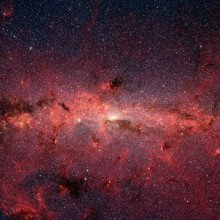
05:24 - Magnetic Meteorites
Magnetic Meteorites
with Dr Richard Harrison, Cambridge University
Scientists have also been using X-rays to look back to the beginning of the Solar System. When the building blocks of our planets first formed four and a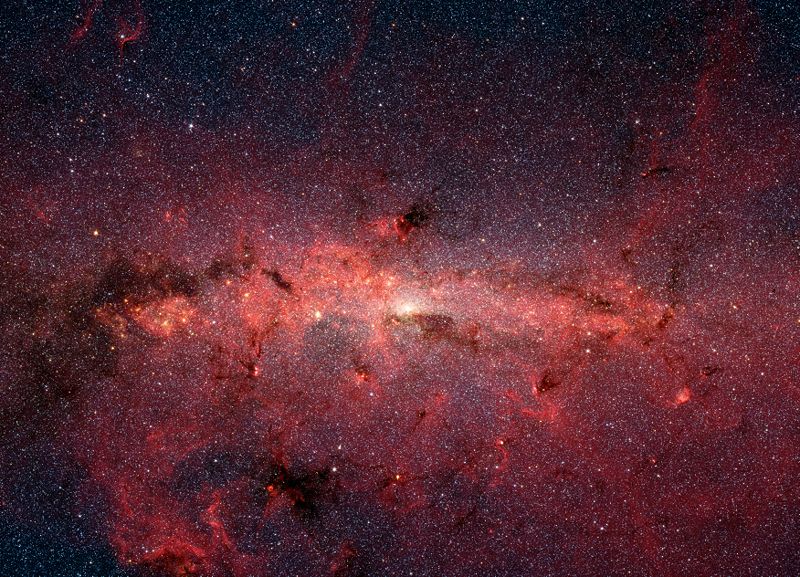 half billion years ago, their molten centres made them magnetic. As they solidified, these magnetic signatures were left behind, written indelibly into the rock for Richard Harrison and his colleagues to find. Georgia Mills went to meet him...
half billion years ago, their molten centres made them magnetic. As they solidified, these magnetic signatures were left behind, written indelibly into the rock for Richard Harrison and his colleagues to find. Georgia Mills went to meet him...
Richard - We started to look at extremely old rocks, in fact, the oldest materials in the Solar System which are meteorites. So, we're very lucky meteorites occasionally fall to Earth and these are fragments of asteroids which are parts of the Solar System rubble left over from the formation of the planets. By studying these meteorites, we get to study ancient magnetic fields that were on the extra-terrestrial bodies that these meteorites were originally derived from.
Georgia - Looking at meteorites in this way has never been done before. It involved using an x-ray microscope called the synchrotron to examine the tiny pieces of metal inside the meteorite which have recorded the long history of its magnetic field. But why look at meteorites in the first place?
Richard - We're interested in understanding what these bodies were like. So, if you take yourself back to the very early part of the Solar System, at the birth of our sun and it was in this sort of early period where the first protoplanets were forming. So, we want to know what those bodies were like, how big they were, how hot they were, what structure did they have. And magnetism gives us a way of looking and peering into the interiors of these bodies by studying whether or not they had a magnetic field. Did they generate a field just like the Earth does? If they do, the answer to that is yes. Then we know immediately that these asteroids had a liquid metallic core very early on. That's one of the unique things we've been able to do with the new methods we've developed for studying this meteorite that allows us to track how the intensity of the magnetic field changed over time. what we've been able to capture is the decay in that intensity over the period of time that coincides precisely with the time that we predict the core would've been freezing. So, it's a kind of a remarkable find really that this particular meteorite we studied, we've actually seen the moment at which the core finished freezing and the field then completely switched off. As soon as you have no liquid left then the magnetic field dies. And that's recorded in the metal of these very unique meteorites.
Georgia - And the Earth's core is itself in the slow process of cooling. Does this tell us anything about what we've got in store for us?
Richard - That's right. Yes, so the Earth also has an inner core. It's slowly cooling and that inner core is slowly growing. It's about 1/8 of the total volume of the core now. And that freezing process is thought to drive our own Earth's magnetic field. So, as that continues to freeze and eventually, the entire core freezes, of course, we expect if the analogy with our asteroid is a good one then we expect the intensity of the Earth's field to gradually decay away. But the time scales are rather slow. So, the Earth's core will not completely freeze for perhaps another 3.5 billion years which is not something we have to worry about but what we would predict on the basis of these results is that the Earth's magnetic field intensity would gradually decay away. The impact of that would be that the solar wind would encroach much closer towards the Earth and start to mess up with our communication satellites and all that sort of thing. So, we can look forward to much poorer mobile reception a few billion years in the future if the sun hasn't already exploded by that point.
09:16 - Human impacts on ecosystems
Human impacts on ecosystems
with Dr Mafalda Viana, Glasgow University, Justine Smith, University of California
Humans don't have a good track record when it comes to preserving the delicate 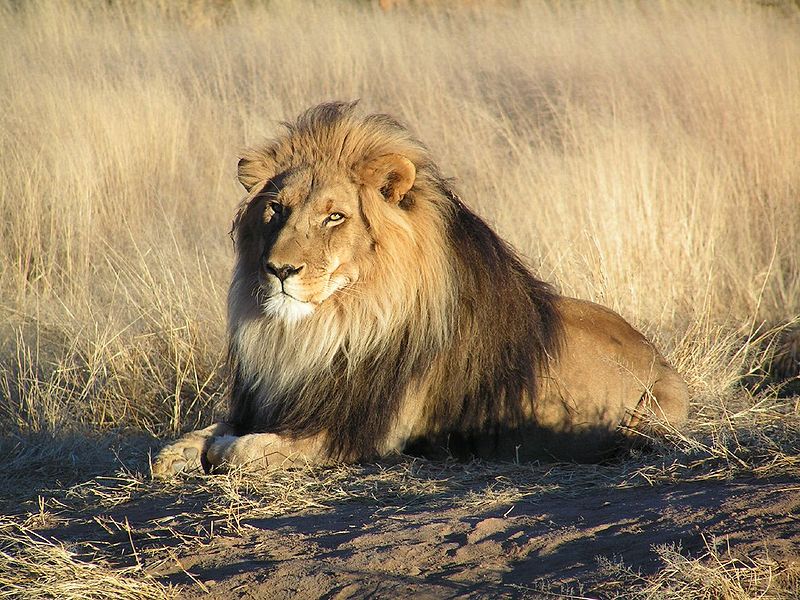 balance of nature, and Khalil Thirlaway has been looking at two recent examples of how our presence can have unforeseen - and unfortunate - consequences for the ecosystem...
balance of nature, and Khalil Thirlaway has been looking at two recent examples of how our presence can have unforeseen - and unfortunate - consequences for the ecosystem...
Khalil - One of the reasons that humans have become the dominant species on our planet is our ability to colonise all sorts of habitats - from wet to dry, cold to hot and high to low. We even change the environment to suit our needs, sculpting the land to build and farm on it. As our population grows, it inevitably leads to us bumping up against the local wildlife which can have complex and far-reaching consequences, including diseases spreading to humans from wild animal populations, as was the case with Ebola. But this is a two-way street and two papers published this week show how human presence can spread diseases among wild animals and also alter animals' behaviour. In Tanzania, dogs are implicated in an outbreak of canine distemper virus that wiped out nearly a third of the lions in the Serengeti National Park as Mafalda Viana of Glasgow University explains...
Mafalda - At that time, we didn't know exactly what was the cause but because distemper virus is a disease typically associated with domestic dogs, it was believed that it was these dogs that live in the villages around the natural park that transmitted the infection into the lions. So, at that time, around '96, there was a vaccination programme that started to vaccinate the dogs in order to not only protect the dogs but also trying to prevent infection into the natural park.
Khalil - But there have nonetheless been several outbreaks of distemper virus in the Serengeti lion since. Were dogs still the cause?
Mafalda - In the beginning, it seems that the domestic dogs could've been responsible for transmitting this disease into the lions. But since the mid '90s, we saw a change in these dynamics, meaning that the infection that would occur in the lions were no longer exclusively related to those happening in the dogs. And so, what it suggests is that the dogs are not the only [species] responsible for transmission to the lions and that there's probably wildlife species inside the park themselves, in addition to the lions, that are maintaining the disease and causing these sporadic outbreaks.
Khalil - But could this have been avoided?
Mafalda - Humans do need to live somewhere and unfortunately frequently creates these human-wildlife conflicts, but hopefully we can find ways of balancing the two.
Khalil - Through vaccination, it's possible to prevent our domestic animals from becoming a reservoir for infection, both to us and local wildlife. But coughs and sneezes are not the only way that human habitation can affect the ecosystem. A team from the University of California Santa Cruz have been studying how housing in and around the mountains of the San Francisco Bay Area is affecting the behaviour of another top predator: the puma, or mountain lion. Pumas hunt large prey such as deer and will often keep returning to a kill to feed for a number of days. Normally, they don't stray far from their prize but if they don't feel safe, they'll often retreat until the cover of darkness. Justine Smith...
Justine - A lot of places in our mountain range where we work are these low-density residential areas where houses are maybe 50 to 100 meters apart and pumas are still using that part of the landscape to hunt and do all sorts of things. When they're near houses, they move far away during the day and sleep somewhere else and come back only at night to feed. And so, these animals are able to hunt right up against people's homes, but they just won't hang around when they feel disturbed.
Khalil - All those trekking back and forth waste valuable energy and combined with the loss of food to scavengers while they're away means that they need to kill more deer just to survive. This puts an increased pressure on the deer population in these areas.
Justine - Here, what we're seeing is really that the humans are sort of the behavioural top predator, if you will, that's changing the feeding behaviour of the natural top predator which is the puma.
Khalil - But there are ways to limit the impact with moves towards more clumped housing development which can be segregated from the puma's habitat, along with other measures to minimise the impact of our daily lives on theirs.
Justine - There has been a lot of attention in the development and planning world recently to look at more conservation planning when we think about designing new areas for development. In terms of places that are already developed there are a number of potential options that could help: constraints on what the kind of light bulbs are there, how strong lights can be, sound ordinances might help to mediate disturbances to animals.
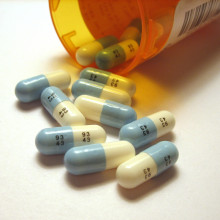
14:16 - Anti-radiation antidote
Anti-radiation antidote
with Professor Gabor Tigyi, University of Tennessee
When the reactor at the Chernobyl nuclear station exploded, some people were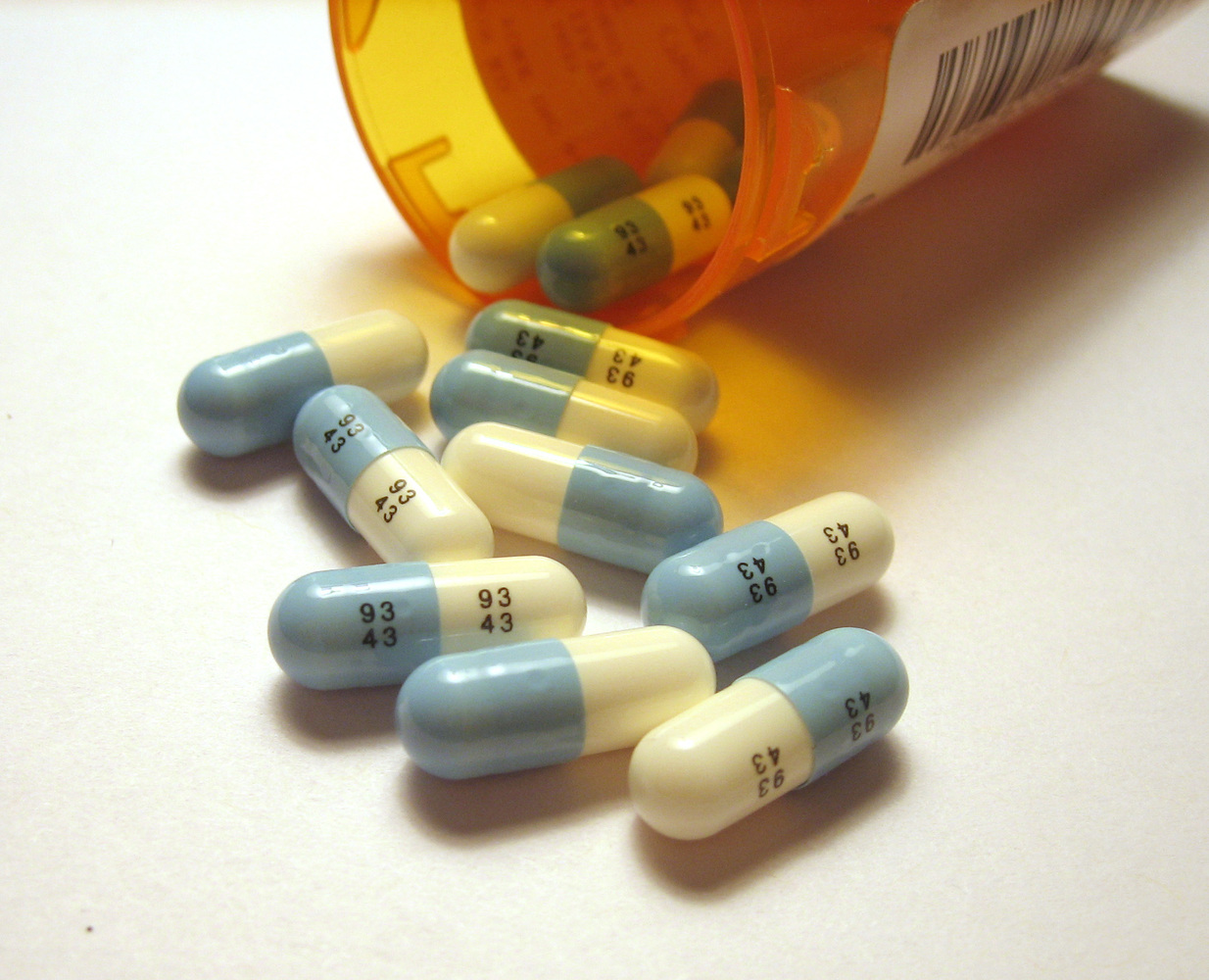 exposed to massive doses of radiation resulting in lethal damage to the DNA in their cells. Now scientists in the US have developed a drug that can protect against this level of radiation exposure, even if it's administered hours after the radiation dose. Apart from being useful in the event of a nuclear accident, the breakthrough might hold the key to reducing the side effects of radiotherapy for patients undergoing cancer treatments, as the University of Tennessee's Gabor Tigyi explained to Chris Smith...
exposed to massive doses of radiation resulting in lethal damage to the DNA in their cells. Now scientists in the US have developed a drug that can protect against this level of radiation exposure, even if it's administered hours after the radiation dose. Apart from being useful in the event of a nuclear accident, the breakthrough might hold the key to reducing the side effects of radiotherapy for patients undergoing cancer treatments, as the University of Tennessee's Gabor Tigyi explained to Chris Smith...
Gabor - Radiation is everywhere. It's there not only in the nuclear reactors but also in the nuclear bombs. But those of us who travel long distances on an airplane are exposed to a higher level of radiation than at the surface of the Earth. This radiation interacts with our cells and above certain levels, it can cause damage. This damage usually leads to breaks in our DNA and unless the cell somehow can fix and restore the blueprint, it may die. So, repairing DNA has to be very efficient.
Chris - So, how are you approaching that? What have you done to try to boost the rate at which cells can put damage to their DNA right?
Gabor - We actually learned something by studying the very simple molecule called lysophosphatidic acid. Generally, in the course of blood clotting that enhance DNA repair and most importantly, increases cell survival after various harmful stimuli. It has a very short half-life in our bodies and it's not like a drug that you can take once a day and then have a long lasting effect. So, what our research group has tackled over the years is to design a stabilised drug-like analogue of this natural substance that can do all the things that the natural substance does - increase DNA repair, self-proliferation, and cell survival. This is in essence what has been accomplished.
Chris - And the chemical you've got, your drug candidate, how have you tested it? Just in a dish or have you actually tried this for real in an animal?
Gabor - Yes, indeed. We had extensive studies carried out in the mice under various radiation injury scenarios - one that mimics damage done by radiation to the bone marrow and also, in another setting to the intestine. In both cases, the compound was highly effective.
Chris - Would these animals or the level of radiation to which these animals have been exposed be equivalent to people who were working at Chernobyl or equivalently say, Fukushima in Japan where the nuclear meltdown occurred in the last few years?
Gabor - Well actually, radiation levels at the base of the reactor at Fukushima produced about a 10 grey radiation dose to those who are the robots that actually went into the vicinity. Our animals were exposed to 16 grey - it's a deadly level of radiation - yet, we had very nice survival outcomes after drug treatment.
Chris - We often use radiation therapeutically and people who have cancer, we can zap the cancer with a blast of radio therapy and this can be very effective. But it does have side effects. It damages healthy tissue in the process. Do you think we could use the approach you have come up with to mitigate some of the damage done to healthy tissue in a person having anti-cancer radio therapy treatment, so that they don't have so many side effects?
Gabor - Indeed. What we are hoping to achieve in the next few years is to actually attenuate the collateral damage that is inflicted by the therapeutic use of radiation. For example, if you have breast cancer, radiation therapy is often used and thus, causes scarring and other side effects in the skin. So, that's something that we would like to try to tackle.

18:21 - Winston Churchill's scientists
Winston Churchill's scientists
with Rachel Boon, Science Museum
 2015 marks the 50th anniversary of Winston Churchill's death. To commemorate the occasion, and to recognise the former UK Prime Minister's contributions, activities are being planned across the UK. Among them is an exhibition at the Science Museum in London called Churchill's Scientists. Rachel Boon showed Kat Arney around...
2015 marks the 50th anniversary of Winston Churchill's death. To commemorate the occasion, and to recognise the former UK Prime Minister's contributions, activities are being planned across the UK. Among them is an exhibition at the Science Museum in London called Churchill's Scientists. Rachel Boon showed Kat Arney around...
Rachel - So Churchill's Scientists is exploring Winston Churchill's relationship with science during the second World War and post war period when he was in power. We look at his relationship with Frederick Lindemann, the first science adviser to government and we explore the work of the scientists who were taken out of their research, put into a very unusual environment during the second World War to develop drugs, to develop radar systems, to analyse attacks and to try and save ships from attacks. And then afterwards, we look at what they did in the post war period, what skills did they learn in that heightened experience of war time research.
Kat - I tend to think of Churchill as the war hero with a big cigar rather than hanging around with guys in lab coats?
Rachel - Absolutely. as a young child, he had quite a boyish fascination with science but never achieved academic glory in the subjects. But he was very interested in the work of H.G. Wells and read Origin of Species. But interestingly, he was the first prime minister to have a scientific adviser constantly at his side. One of the legacy is that we look at in the show is how that appointment of a scientific adviser became common in every government after Winston Churchill's first term as prime minister. Churchill was very visual and Lindemann and a group of his scientists called the S-Branch brought together science in a very visual way, looking at graphs. If we just walk around the corner, I can actually point one out to you so I can describe it. So, he had his own statisticians who brought together information looking at cargos lost at sea, the stocks of food types looking at bacon and ham, and cheese, things that Britain really depended on as imports. The way that they depicted this information is using this very colourful graphs as we could see here.
Kat - These look like the kind of infographics we see in the papers today except they look hand drawn and coloured in with felt tip pens.
Rachel - That's absolutely correct. So, this is actually the first time that these graphics have been in an exhibition and they come from the Churchill archives in Churchill College in Cambridge.
Kat - So, let's go and have a look at some other things. we're now in a section called health and nutrition. So, let's have a look at these two people here, Robert McCance, Elsie Widdowson. Tell me what they were up to to prove whether you could or couldn't live successfully on rationing.
Rachel - The two nutritionists, just before the outbreak of second World War, they were working at Cambridge. They were interested in the nutritional value of food. When it looked like war was on the verge of outbreak, they led a team of willing volunteers and actually tested the effects of reduced diet and they did this by heavily reducing their intake of food and then subjecting themselves to rigorous exercise in the lake district. Their important finding is that they were concerned that there might be calcium deficiency if the British public didn't have enough milk and cheese which is what they depended on, on imports. So, they suggested putting in calcium carbonate or chalk into bread and that's something that continued long after the second World War.
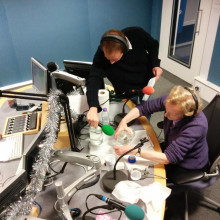
22:36 - What is plastic?
What is plastic?
with Dame Professor Athene Donald, Cambridge University
Plastics play an important role in almost every aspect of our lives. Look around you now: toothbrush, car steering wheel, toys, pens, kitchen white goods, tupperware,the list goes on! Plastic is everywhere! Chris Smith lifts the lid on what plastics are with Cambridge University's Athene Donald...
Athene - Okay, so to me as a physicist, I would probably call them polymers. They're long chain molecules. Most simple things around us are small molecules. So something like water is just H2O - two hydrogen atoms and an oxygen, whereas polymers are long chains, many, many atoms long as it were. Polymer means many units so that they have blocks of units which repeat all along the chain.
Chris - By changing the chemicals that are in that chain, you can get different things that behave differently or have different properties.
Athene - Absolutely. So, the simplest is polythene or polyethylene which is just the repeat of CH2. So, one carbon and two hydrogens and the carbon atoms join together to form these long chain molecules. But other polymers are much more complicated than that.
Chris - Now, you've kindly agreed to show us a chemical reaction that revolutionised the lives of women everywhere with the creation of nylon stockings back in the sort of '40s and late '30s. You're going to do the chemistry Athene, here in the studio for us to make some nylon. We won't make stockings but can you talk us through actually how this works and what you're going to do.
Athene - Okay, so what I have in front of me are two glass bottles, each a litre in size, so like a litre of milk. These are clear transparent fluids I've got. One is hexamethylenediamine in sodium hydroxide and water.
Chris - Easy for you to say.
Athene - Well, I can read it off the label. The other one is sebacoyl chloride and hexane. So, solution A, that first one I said and I'm not going to repeat it, I've already got a small amount in this glass vile.
Chris - So, you've got literally a centimetre's worth in a little bottle beside the big bottle.
Athene - That's right. I've just put a little in there and I've got a glass rod with a hook on it. I'll explain why I've got the hook in a minute and what I'm going to do is pour some of the second solution in - if I can get the lid off - and I'm going to pour this down in the glass rod to try and form a stable layer between the two solutions. And then the point about the hook is that...
Chris - I see. We've actually got a liquid sitting on top of a liquid now with the glass rod going between the two.
Athene - That's right. The second solution is less dense than the first one. So, it floats on top and at the junction between these two fluids, at the interface, there's a reaction going on and I should...
Chris - It looks like a spider web.
Athene - That's right and I should be able to pull out this rope of nylon.
Chris - Wow! So literally, it's coming from the layer between the two liquids. We've got what looks like a spider web material and you're drawing it out. It's now - wow! That's 15, 16, 17 centimetres, still going.
Athene - That's right. I should be able to pull it for a very long way. It gets thinner and thinner and I have to pull it quite slowly because what I'm doing is picking up the nylon that's forming at the interface between the two liquids where the reaction is occurring.
Chris - What is the chemical reaction that's happening just in simple terms? What's going on here?
Athene - It's known as condensation reaction. So, the two reagents mix together. They give out in fact in this case, hydrochloric acid, HCl. What is left is the two main bits of the chemicals joined together to make this long chain molecule. And there, it's broken. I'm afraid it's got to about half a metre.
Chris - It's pretty impressive out of a tiny little bottle in the studio and this is just one type of polymer. So, what sorts of qualities and properties do these sorts of plastics and polymers made in this way have that makes them special?
Athene - They are mainly pretty strong. They are very flexible and perhaps the way we find them most useful is it's very easy to form them into different shapes. So, if you're trying to make - I'm old enough to remember enamel washing up bowls and they always had to be round. But you could make a square or rectangular washing up bowl out of plastic. You can form it into these shapes and that's actually much less likely to tip or sort of collapse under the weight of the water. So, one of the key things is the ability to make into different shapes at quite low temperatures. Not the kind of hundreds and hundreds of degrees you need for instance with metals.
Chris - When you refer to temperature, that's quite important too because plastics do deform or change their shape when you heat them. So, why is that and how can that be used?
Athene - Okay, so as I say, these are long chain molecules and in something like this example of the nylon rope, those molecules get all tangled up rather like knitting wool or something like a bowl of spaghetti. But that means the molecules can only move very slowly past each other. And so, if you go to high temperatures, there's quite a lot of mobility. But at room temperature, most of these molecules are essentially frozen into place. So perhaps, I can illustrate it with this second demonstration I've got which consists of a plastic cup, the kind of thing you would have at a drinking fountain. It's just a regular cup like that. And it's formed into this shape. We all know what shape a plastic cup is. But if I heat it up, so I've got a quite powerful hairdryer here. If I heat it up, it will shrink back to the shape from which it was made. It will take a little while to get going and you can see it's crinkling up. We're giving enough thermal energy to the molecules. Giving enough heat to the molecules for them to retract back to the shape from which this cup was originally made and the cup was originally made just from a flat disk and you can see it there.
Chris - We have indeed got a flat sheet of plastic. It's about 5 or 6 centimetres across.
Athene - So, it's the size of the base of that original cup, but the shape of the cup was made by shaping it around some kind of mould at high temperature and then cooling it to room temperature and it will stay in that shape. There's nothing that's going to make it change shape at room temperature.
Chris - Because those chains of molecules cannot slip past each other until they're made hot enough again.
Athene - That's right, yes.
Chris - The one thing that people are always telling us though is that, if I dump that in the waste paper basket, I've got a problem because it then is not going to breakdown anytime soon. That must be one aspect of plastic - whilst they're very useful, they're very durable, we do have the downside, they don't biodegrade.
Athene - That's right. If you break it up into very small pieces, it sort of becomes much less visible. But most of the bugs can't digest them essentially. One of the ways of making biodegradable plastic bags is really, to mix in the polythene with starch and the starch which is natural does degrade. And so, you get just tiny fragments and you no longer see that bright orange Sainsbury's bag or whatever.
Chris - But the bottom line is, because the plastic contains molecules with chemical bonds in them that you don't naturally find in the environment, there are no bugs out there like fungi and bacteria that know how to eat that. So, it doesn't break down.
Athene - So, there are no common bugs. I wouldn't like to go quite so far as to say there aren't any because bugs are amazingly clever things.
Chris - So, there may be a plastic cup digesting bugs somewhere, but they're not that abundant or it's not as abundant as the plastic bag.
Athene - They're not yet in landfill. Yes, I think that's right.
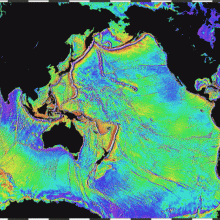
29:53 - How much plastic is in the ocean?
How much plastic is in the ocean?
with Captain Charles Moore, Algalita Marine Research Foundation
According to the United Nations global plastic production has gone from 5.5 million 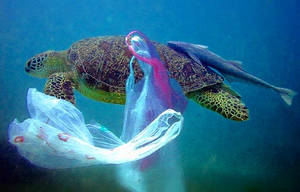 tonnes in the 1950s to 110 million tonnes in 2009. And because plastics are resistant to the processes that break down materials naturally, they can accumulate in the oceans.
tonnes in the 1950s to 110 million tonnes in 2009. And because plastics are resistant to the processes that break down materials naturally, they can accumulate in the oceans.
Captain Charles Moore from Algalita Marine Research Foundation was the first to document what he dubs the 'Great Pacific Garbage Patch, a huge floating mass of plastic aggregated by ocean currents. He told Kat Arney how he found this island.
Charles - Well, I found it by accident, returning from Honolulu to California. I took a shortcut through an area known as the doldrums or the north pacific high. So repeatedly, for an entire week, small bits of plastic floating by and decided to come back and measure it scientifically and found to my surprise that there were 6 times as much plastic as plankton floating on the surface in this area. So, what you've got is a plastic soup. Now, that soup is bulked out with larger croutons of material and in this last voyage, I actually found a floating island that I walked around and did a kind of a tour. I felt like Captain Cook. I mapped it. I took its position. I named the coves on it. It's quite exciting for a plastic researcher to find a floating plastic island. But basically, what you want to envision when you think of these garbage patches is the equivalent of hundreds of miles of harbour debris attached to each other basically from a couple of hundred miles up the California cost all the way to China in the case of the north pacific, which is my field of expertise.
Kat - So, my question is, where has this all come from?
Charles - It comes from everywhere. We live in the age of plastic. Our lives have plastic in them from dawn until dusk. We're creatures of the plastic age. They deliver our food, we wear them, we make our cars out of them. There's alternatives for every natural material out of plastic and alternatives for every manufacturing material from steel, to aluminium, to glass. All those natural materials that were formally the basic building blocks of industry have now largely been replaced by plastic. New ways of using it and are developed all the time, the problem is, recovery of the material has not kept pace with the creativity of the industry and the inundation of it into the entire world economy. Now, China has embraced the throwaway lifestyle, Indonesia, Malaysia. We just have this material, very light that is able to blow and wash into the sea since the sea is downhill from everywhere and we're not recovering it in any meaningful manner.
Kat - This sounds like quite a serious problem, but it's in the sea. What harm is it doing? Is this actually damaging the ocean life?
Charles - I have proposed the hypothesis which we're currently testing and I think other scientists should get on-board that more animals are killed right now by plastic in the ocean than by climate change. I think the death toll is alarming. It's in the millions of creatures killed annually by entanglement, by ingestion, by becoming starved by this stuff. Not to mention the fact that all the run off of oils and greases and pesticides sticks to plastic. Plastic is hydrophobic (water fearing) but lipophilic (oil loving) and all of our chemicals are oily and they stick to plastic and then transmit through the food web. And now, we're finding 11,000 cases in the average diet of the shell fish consumer in Europe. We're finding in every gram of oyster meat and every gram of mussel meat in the Gulf of Maine, 15 particles of microplastic. So, it's now part of our food.
Kat - I guess the other question is, this is just one that's off the coast of the Pacific Coast. Are there other aggregations of plastic like this in our other oceans and is this a growing problem for us?
Charles - Yeah. I mean, there's an Around the World Race going on right now and they are becalmed in the Indian Ocean. And so, there's nothing for them to do. And so, reports are coming in of seeing plastic as far as the eye can see from all these Around the World Races that would rather be dashing through the waves but now, they're becalm and they're seeing all these plastic. North and south Pacific, north and south Atlantic and the Indian Ocean all have these gyres, subtropical gyres that act as accumulators for this plastic. We've now sampled all of them and published the paper and found trillions of particles weighing hundreds of thousands of tons. It's a huge amount of plastic out in the ocean.
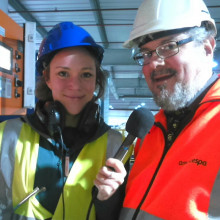
35:12 - Can plastics be recycled?
Can plastics be recycled?
with Mark Shelton, AmeyCespa Ltd, Cambridge City Council
To reduce the global impact of plastics - and to save money - many countries now promote "recycling" programmes to keep plastics in circulation and out of landfill, or the ocean. In Cambridge, where we are, recyclable waste, including paper, metal, glass and plastics, goes into special "blue bins" that are collected and processed separately. But what happens next? Hannah Critchlow followed her rubbish on its journey to - and through - the recycling plant...
Hannah - I've just been food shopping. What's for dinner tonight? Well, let's 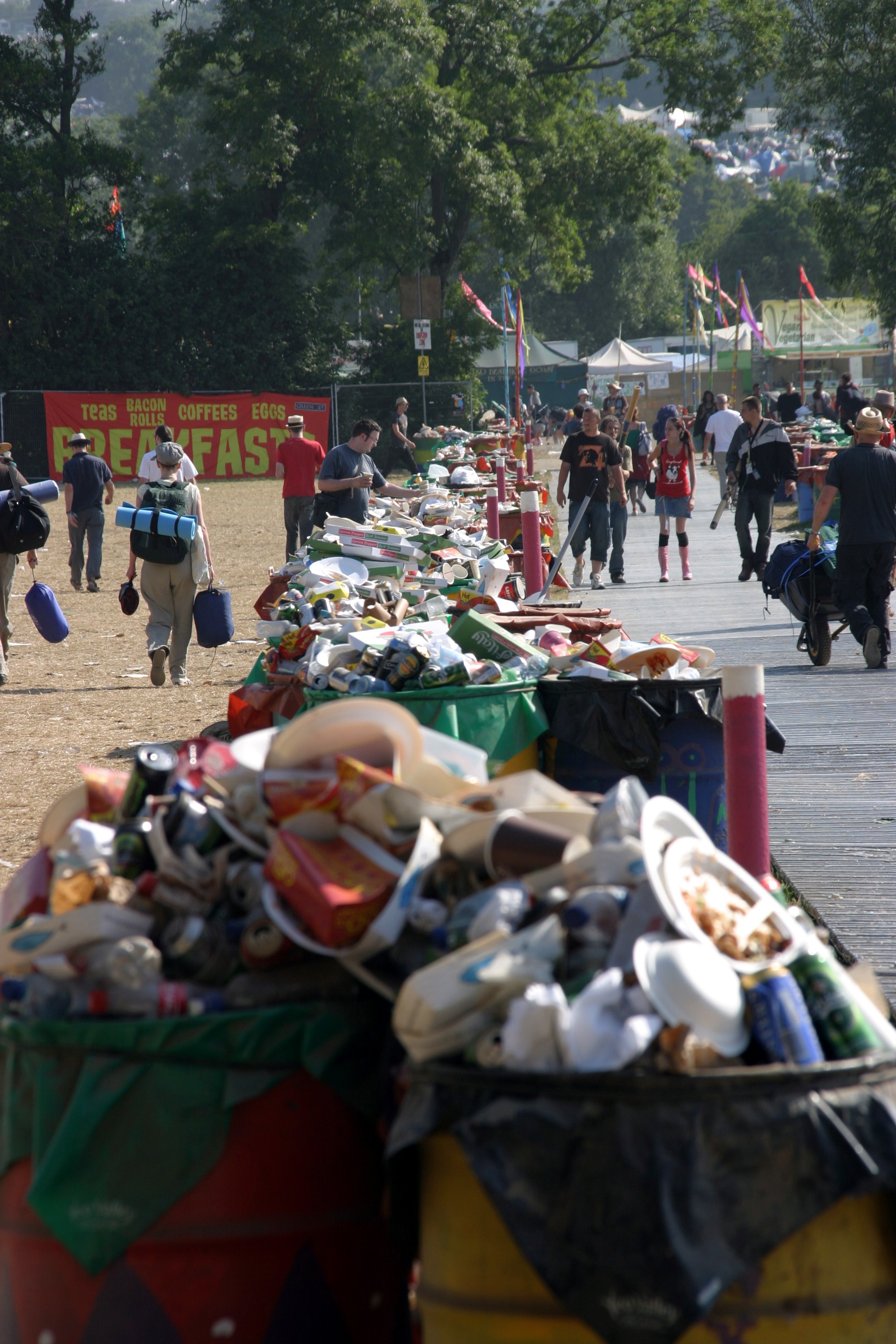 take a look in the bag - burger with kale, mushroom, fries and a glass of wine, followed by yogurt, milk and a tin of prunes for my morning breakfast. Well, my stomach is satisfied but I seem to have immediately produced a lot of waste, all of which goes in my blue recycling bin. But what happens to this detritus now? Cambridge city council serves over 50,000 households including mine and I met the man who pick up our rubbish for recycling on their morning rounds.
take a look in the bag - burger with kale, mushroom, fries and a glass of wine, followed by yogurt, milk and a tin of prunes for my morning breakfast. Well, my stomach is satisfied but I seem to have immediately produced a lot of waste, all of which goes in my blue recycling bin. But what happens to this detritus now? Cambridge city council serves over 50,000 households including mine and I met the man who pick up our rubbish for recycling on their morning rounds.
Mark - I'm Marco from Cambridge.
James - James from Great Shelford.
James J - James from Cambridge.
Hannah - How many bins do you empty each day?
Mark - Maybe around a thousand to 1200 at least.
Hannah - Each day?
Mark - Each day, blue bins we pick up around 12 to 13 tons a day.
Hannah - You guys got quite a lot of exercise, don't you, running around?
James - Yeah. It keeps us very fit indeed, yes.
Hannah - Do you know how far on average you might run each day?
James - Between 12 and 15 miles a day. Behind the lorry, yup trying to keep up.
Hannah - I left these chipper chaps to continue their round and followed my blue bin waste 8 miles up the road to the next stage in its recycling journey.
Mark S - Mark Shelton. I'm waste education manager at AmeyCespa at 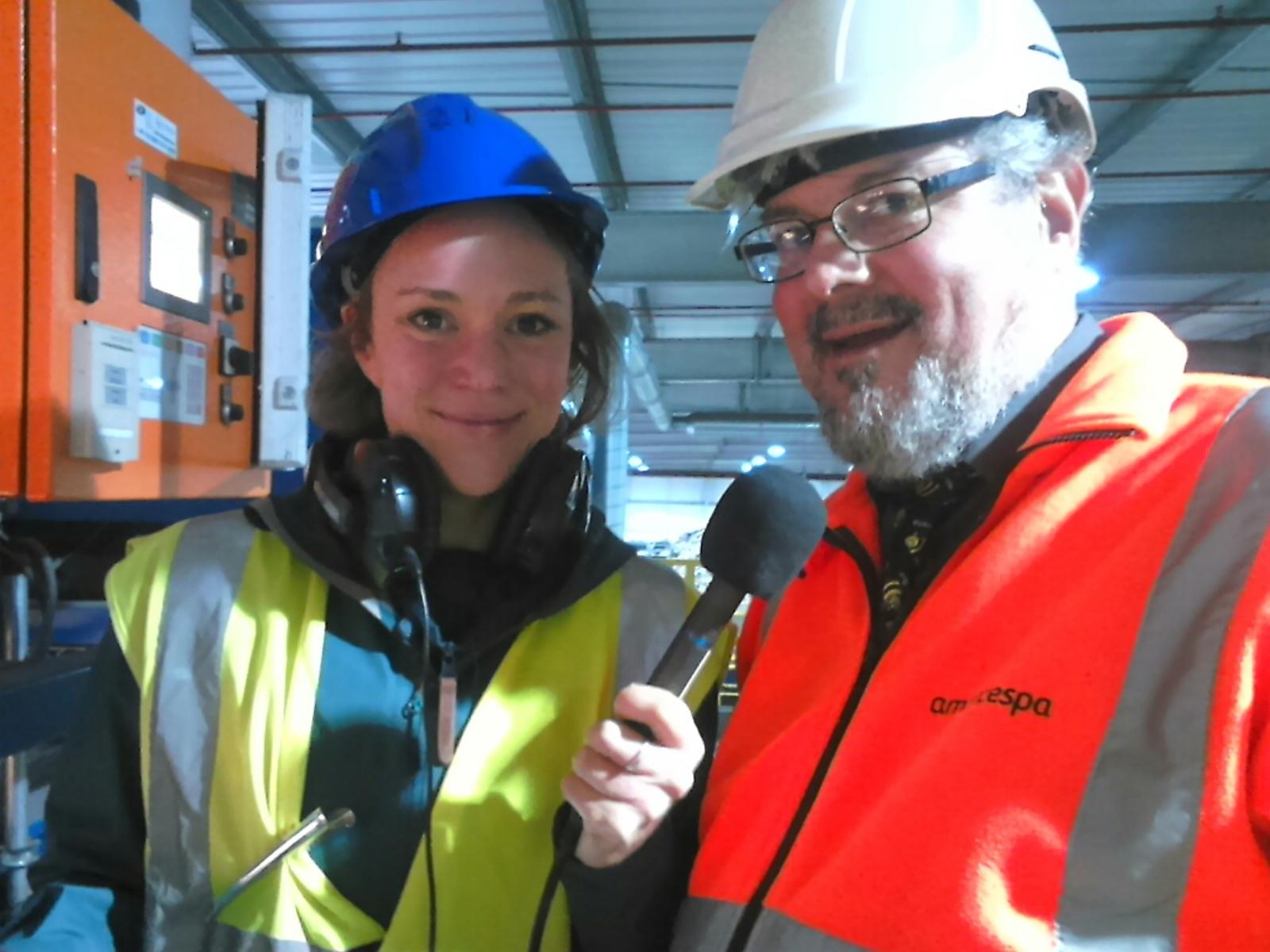 Waterbeach. We're in the materials recovery facility at Waterbeach where we take 350 tons of mixed waste every day from the council's blue bin collections.
Waterbeach. We're in the materials recovery facility at Waterbeach where we take 350 tons of mixed waste every day from the council's blue bin collections.
Hannah - We're stood in front of a very complicated looking football stadium-sized pitch area of conveyor belts which are multi-layered, one on top of the other. So, 350 tons of blue waste rubbish are zooming past on this conveyor belt every single day. How exactly are they being separated?
Mark S - There's a range of different machinery that the conveyor belts feed into. So, the first bit of machinery separates out glass. It's basically a crusher that crushes the waste and then there's a series of vibrating plates that separate out the glass. The next stage is the cardboard separator and that separates out old corrugated card like the large brown boxes. Simply because it's much larger than everything else. It then passes to a machine that separates out paper and that's called a star screen. It's got a series of revolving wheels in the shape of stars. The paper rides across the top of the wheels and the rest of the waste falls through.
Hannah - A series of magnetic separators then remove the metal cans for recycling. We're now left with some very different plastics - my milk carton, plastic bag and film, burger tray and yogurt pot. How are these all managed?
Mark S - We've got three near infrared separators and they separate out the plastic on the basis that different polymers reflect different wavelengths of near infrared light. So, the plastic is moving along a conveyor belt. Near infrared light beams are shone down on the plastic. There is a receptor that picks up the reflected wavelengths. That then works some air jets and the air jets are able to blow different polymers in slightly different directions to separate them.
So, we're standing now beside a near infrared separator now and in the background, you can hear that noise which are the air jets. You've got a conveyor belt in front of us rolling very quickly. The plastics are coming along the conveyor and they're blown across the divide wall. The plastics that are being separated out by this particular piece of equipment, pots tubs and trays are being blown over the divide wall and the other plastics are just falling straight down and then the plastics fall straight down. We'll go to the next separator.
Hannah - Mark and I moved away from the rubbish stench to a quieter place to explore the next part in the plastic journey.
Mark - Plastic is very light so we want to bale it as compact as we can so that when we're transporting it in the lorries to the actual companies that do the recycling, the reprocessors themselves, we're using as little diesel as possible.
Hannah - And so, these bundles, these bales that look very similar to hay bales although obviously, they're made of plastic.
Mark - And they're a lot larger. Yes, we need a forklift truck to lift them. We put them into lorries and they take the materials to different reprocessors, the people who actually do the recycling. The plastic bottles, the milk containers, fizzy bottles go to a company called Jayplas who are based in Corby and they're able to turn the material back into food grade plastics which are used for food containers and drinks containers. So, more bottles ready for refilling. Corby is one of our most local reprocessors. They're only about 50 miles away. The pots, tubs and trays, they may well go to Europe because the industries that actually use that material to make new pots, tubs and trays again, it goes back into food grade plastics, are based in Belgium. The plastic film may have to go slightly further perhaps to Malaysia again, because that's where the industries are that require that material and that's used obviously instead of a raw material and that is then made back into a range of different products. It could be new bags.
Hannah - Plastic recycling seems to require a lot of energy. I asked David MacKay who worked as chief scientific adviser to the government on climate change if it was all worth it. He jotted down some calculations and said that as a guideline, to ensure recycling is nowhere near pointless. His rule of thumb is that waste shouldn't travel more than 600 km by road or more that 6,000 km by the more environmentally friendly method of ship or rail. Although he added that since plastic is made from fossil fuel of which there is a limited supply and reprocessing emits less carbon emissions than the energy costs of obtaining more oil to make new plastic a few more transport miles could be added to the equation. Well, I followed my plastic waste on its recycling journey. It'll be born as a new plastic product that I can use again and again. So, I'll keep sorting through my rubbish for recycling and Mark Shelton at AmeyCespa added that they were looking to send their sorted plastics to reprocessing plants closer to home in the future.
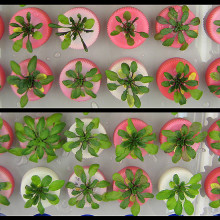
42:20 - Plastics from Plants?
Plastics from Plants?
with Professor Karnik Tarverdi, Cambridge University
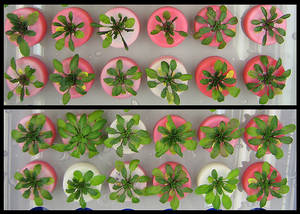 At the moment, plastics are produced industrially using oil as a raw material. But, in future, it might, quite literally, grow on trees! Karnik Tarverdi, Professor of Materials Processing at Brunel University spoke to Kat Arney about the plastics of the future...
At the moment, plastics are produced industrially using oil as a raw material. But, in future, it might, quite literally, grow on trees! Karnik Tarverdi, Professor of Materials Processing at Brunel University spoke to Kat Arney about the plastics of the future...
Karnik - Hi.
Kat - So first of all, do we really need all the kinds of plastic that we have in our lives at the moment? So, if I go to the supermarket, I might get a nice salad, I pick up a lettuce and a cucumber, and they're shrink wrapped in plastic. Why are they packed like that?
Karnik - Yes, I'm glad you mentioned cucumber because that has some very interesting statistics. First, I'd like to mention that regarding cucumbers, there's a very interesting informative book written by Laurel Miller and Stephen Aldridge. They're veterans in this area and the title of their book is, guess what, "Why Shrink-Wrap a Cucumber?"
Kat - There you go. Why should we? Why do I need to use this plastic to do it?
Karnik - Now hopefully, I'll try and convince you why we do it, why the industry does it. Now, if we shrink-wrap the cucumber, it loses 1.5% of its weight in 14 days. But if it's not shrink-wrapped, it loses 3.5% in just 3 days.
Kat - So basically, it's going off in my fridge faster if it's not wrapped up.
Karnik - Yes, exactly. And then with shrink wrap, it has much lower carbon footprint. It has a longer life in the fridge and also, wherever it's kept really.
Kat - I guess this is a bit counterintuitive because people may think, plastic packaging, it's always bad. Why do we need it? If it does keep our foods cleaner and safer and better for longer, it's a good thing. But can we recycle this kind of packaging?
Karnik - Yes. First, let me mention that in the UK, we use about 10 million tons of packaging per annum. Yes, it's a lot of material, but what we need to do is make sure that this material has a recycling lifecycle. It's produced, it's used, and it can be professionally recycled and reused again.
Kat - But is there a limit to the number of times say, that the shrink wrap from my cucumber can be recycled?
Karnik - Yes, there is. But what we do is you can always replenish it with some virgin polymer. When you're recycling, it needs tender, love and care. That means you need to have the temperature just right with some flow promoters and also some anti-oxidants which will then extend the longevity of these polymers.
Kat - But assuming that no one is going to recycle all their shrink wrap ever and people will just chuck it in the bin, tell me about the work that you're doing to try and make plastics that are actually more biodegradable from natural products. Tell me about these. How do they work?
Karnik - Yes. This is interesting area but there's quite a lot of work being done and also of course, at Brunel University, I've got PhD students working in this area. There are quite a range of sugars that can be used to recycle and also, make new polymers.
Kat - We had Athene talking about starch earlier, is that...
Karnik - Yes. In fact, Brunel was one of the pioneers in processing starch and there are a couple of large companies that make loose fill plastic made out of starch. So, it's excellent packaging and it's taken over, around 25% of polystyrene loose fill which is excellent. But the polymers that are made out of plastic, recycled and also, biodegradable is quite a big range now. But PET and polypropylene play a big role. PET is from sugarcane. It's sugar but the big advantage of that is that when you process this material, it has good barriers against volatiles, against carbonation material inside a liquid.
Kat - So, you can store all kinds of things, all sorts of food and sorts of products in this kind of plastic.
Karnik - Yes, very much so and again, it has a good longevity as some of the bilayer materials that are being used nowadays. But the biodegradable polymers are also playing a big role. There is a special polymer called polyhydroxyalkanoates, it has polyhydroxybutyrate and polyhydroxyvalerate. These are again, sugar-based from plants, but generated through bacteria sources and they are biodegradable. They will do degrade but also, from nature works, they generate a polylactic acid from cornstarch. That is again biodegradable, but at much higher temperatures. So, if it's in very large compost bins then it will degrade in municipalcompost bins.
Kat - It will get a bit warmer.
Karnik - Yes, exactly.
Kat - So, the kind of the lifecycle of a biodegradable plastic, a farmer might grow some sugar beet or some of the other plants that are used. You'd extract the material, polymerise it, turn it into these plastics, and then I guess, do I just chuck it in the bin?
Karnik - Yes, most of it can actually be mixed with say, if it's PET with PET and recycled. But the new technology that is being developed is to identify, which is from plants and which is from mineral petroleum. At the moment, you can definitely mix both PETs and end up using it again for bottles and for anything else that anyone wants to use.
Kat - Now, one thing that always concerns me about biodegradable plastics, I've got a nice drinking glass here in the studio. I assume this is not biodegradable. It's filled with water, I'm drinking out of it. I worry that it will just disintegrate on me. How stable are these plastics in their use?
Karnik - Yes, they are. They are very stable. In fact, the biodegradables from polyhydroxyalkanoates, which one of my students is working and there are other scientists in the UK and overseas that are working on these, they are very stable materials and you need to treat them carefully. You need to process them at the right temperature. But once they are processed, they're as good as any polymer.
Kat - But then when you get them in the compost heap, that's when they degrade.
Karnik - Yes. When the bacteria starts attacking it and breaking down, taking all the nutrients in the way, and eventually it all ends up like soil itself.
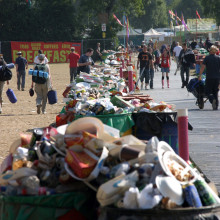
How much can we recycle?
Athene - There's a big variety. One of the problems with recycling plastics is that if you take different kinds of plastic and put them together, they don't mix at all well, so you don't end up with a good product. The ability to sort plastics which you are hearing about is really transforming that. So, there is a variety and it's a question of, what end-product you're trying to make, whether recycled plastic is good enough for it.
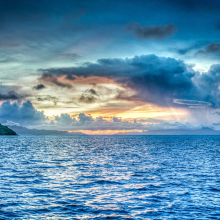
What happens to the plastic in the ocean?
Charles - Well, there's three basic processes. One is photo degradation where UV rays crosslink the molecules and make them brittle so that it breaks apart very readily in wave motion. Another one is the extraction of the plasticizers that soften and make the material flexible by the ocean itself like the seawater itself is very good at extracting the plasticizers that make the plastic supple. And the third mechanism that I'm thinking is much more prominent than has been given a role in this process is the biting of the material by sea creatures. Practically, every piece of larger plastic that we pull up out of the ocean has the edges nipped off. I think a lot of these small fragments are created by munching the edges of plastic as it floats in the ocean.
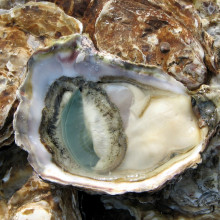
What happens when I eat plastic?
Charles - With regards to human ingestion of plastics, it contributes to what we call the body burden of synthetic chemicals which were basically unknown before 1950. All of us now have a very heavy body burden of synthetic chemicals. Plastic is very good at absorbing synthetic chemicals that have washed into the ocean - pesticides, herbicides, industial chemicals, anything petroleum based - preferentially sticks to plastic because it's lipophilic (oil loving) and that desorbs in our digestive systems into us. So, the body burden of synthetic chemicals in our bodies is increased by the ingestion of seafood that contains plastic.
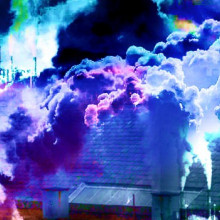
Should we just burn plastic waste?
Athene - I think a lot of it ends up in landfill, but I think that doesn't mean that's how it has to end up. I think we could do a much better job. There's another aspect that hasn't been mentioned at all that actually, plastics coming from oil can in fact be burned and get energy back out of them as if you're going back to the virgin oil. The trouble with this process is it's very effective if you have a sort of closed environment and very high temperatures. But if you do it at lower temperatures then there are some nasty chemicals that can be released. I think that's why people haven't gone that route.
Chris - Is it worth considering or part of the equation, we regard plastics as bad because they're a use of a fossil fuel, oil, but while they're plastic, they're not turning into carbon dioxide in the atmosphere and therefore, contributing to things like global warming for which we condemn fossil fuels? So, are they therefore less of a burden or less of a bad thing than if you do burn them or if you do turn the oil into petrol?
Athene - I think that's a very complicated question and I certainly don't know the answer. I think it depends on many different things, probably including which polymer it is. There are all these different aspects. Certainly, now oil is cheap again, people may be worrying less about the original material. But of course, we do still have a finite amount of oil and we should be worrying about what we're doing with it.
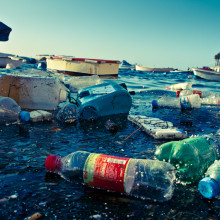
Vacuum cleaners to clear ocean plastic?
Khalil - I guess the ocean could do with a bit of a spring clean. One person who knows a great deal about marine pollution is Professor Peter Franks of the Scripps Institution of Oceanography. I floated the question past him.
Peter - Coincidentally, there's an instrument that does exactly what you propose. It's called CUFES or Continuous Underway Fish Egg Sampler. It's a big tube attached to the side of a ship that sucks up water which is then processed through a series of sieves to separate the fish eggs for sorting and counting by the scientists.
Khalil - That's convenient. It appears this is going to be a rather short edition of Question of the Week or is it?
Peter - It turns out that it's an incredibly inefficient way to get the plastic out of the ocean. The ocean is huge and systems such as these sample in insignificantly tiny fraction of it. Even if all the ships in the world had such systems, it would not make any difference to the amount of plastic in the ocean and increased fuel usage due to the drag of the system would increase the CO2 being pumped into the atmosphere, enhancing global climate change.
Khalil - Okay, it looks like ship-based cleaning is out of the question then. But what about a purpose-built floating vacuum cleaner?
Peter - There have been several proposals to do this. The problem is that most of the plastic in the ocean is in tiny particles, about the same size as the plankton - the tiny organisms that live in the ocean, so any attempt to suck up the plastic will also suck up the plankton.
Khalil - Plankton is a crucial part of the marine food web, providing food for organisms as small as shrimp and as big as whales. Messing with the plankton could throw the entire ecosystem out of kilter - not good. Using charged electrodes will be problematic too as salt water has a habit of corroding metals extremely effectively, especially when they've got an electric charge. We also don't know what effects the electricity might have on plankton and other sea life.
Peter - That being said, it might be possible to drag lines behind ships to recover lost fishing nets and larger plastic items. Though this wouldn't solve the problem of the tiny plastic particles in the ocean, it might help to reduce ghost fishing by those lost nets.
Khalil - Ghost fishing is a problem caused by abandoned fishing nets and lines which drift around the ocean, trapping and killing organisms indiscriminately. Removing these would certainly help protect ocean dwellers from this grim fate.
Peter - The problem is that such systems will always affect the organisms of the ocean one way or another. The better solution of course would be to stop putting plastic into the ocean, or anywhere else for that matter.










Comments
Add a comment